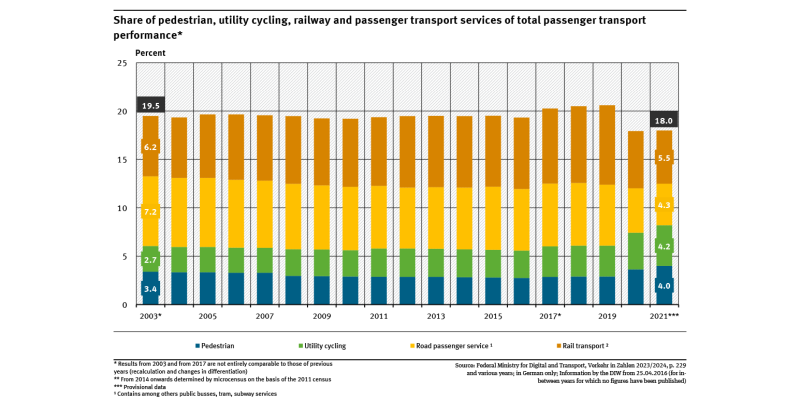Indicator: Environmentally friendly passenger transport
 Click to enlarge
Click to enlargeSource: Federal Ministry for Digital and Transport Figure as PDF
 Umweltbundesamt
Umweltbundesamt
 Click to enlarge
Click to enlarge
- The share of environmentally friendly passenger transport has remained more or less constant since 2003, only slightly increasing until 2019 and reaching 20.6 %. Due to the pandemic it decreased in 2020 and 2021 to around 18 %.
- To keep the environmental impact of passenger transport low, the share of environmentally friendly transport in total passenger transport should be as high as possible.
- The Federal Government’s National Cycling Plan is to support cycling as a means of transport; a federal strategy for pedestrian traffic is currently under development.
Passenger transport has long been dominated by the car, what is known as individual motorised transport (IMT). In 2019 the IMT share was at 73.6 %, its transport performance increased significantly in the last years (until 2016). The share of motorised private transport was 73.6 % in 2019, and its transport performance has increased significantly in recent years (up to 2016). Air transport had a share of just under 6 % in 2019. In 2020 and 2021, the share of motorised private transport even rose to around 80% due to the pandemic, with public transport and air traffic in particular declining significantly. It should be noted that a recalculation of the mileage and consumption calculation and the passenger transport model was carried out from 2003 and 2017 onwards, which somewhat limits comparability with previous years.
Car traffic is a heavy burden on the environment through greenhouse gas emissions, air pollution and noise. In addition, stationary as well as moving traffic takes up space. Overall, apart from aviation, public transport modes have a better environmental balance than cars with average occupancy. The use of bus, train, walking and cycling have been summed up under the term ‘Umweltverbund’ or eco-mobility. The indicator shows the share of eco-mobility in passenger kilometres travelled. This share should be as high as possible.
Our mobility is increasing. Between 1976 and 2019, passenger transport almost doubled in Germany, to recently around 1.246 billion passenger kilometres. While in 1976 the share of environmentally friendly transport modes was around 24 %, it has fallen to 20.6 % by 2019, and due to the pandemic 2020 and 2021 to around 18 % in 2020.
The "National Cycling Plan" (NRVP) was developed to promote cycling, and the new NRVP 3.0 was presented in 2021.The NRVP also supports pilot projects at the intersection of cycling and walking. The Federal Ministry of Transport, Building and Urban Affairs is currently developing a strategy for the federal government, particularly for strengthening the safety and attractiveness of pedestrian traffic.
Ultimately, the traffic performance of the MIV in absolute figures is decisive, as well as the shares of fossil fuels in fuel consumption. This has a significant influence on the development of energy consumption and transport emissions (cf. Greenhouse gas emissions, in German only). Progress so far has not been sufficient.
Official statistics by the Federal Statistical Office of Germany do not actually monitor motorised individual transport, walking or cycling. Instead, the figures are approximated by the German Institute for Economic Research (DIW) using a passenger transport model. This model is based on results of the ‘Mobilität in Deutschland’ (BMVI 2018, in German only) survey and the 2011 microcensus. A more detailed description of the method can be found in the yearly published ‘Verkehr in Zahlen’ (BMDV 2023, in German only).
More detailed information: Fahrleistungen, Verkehrsleistung und Modal Split in Deutschland (in German only).